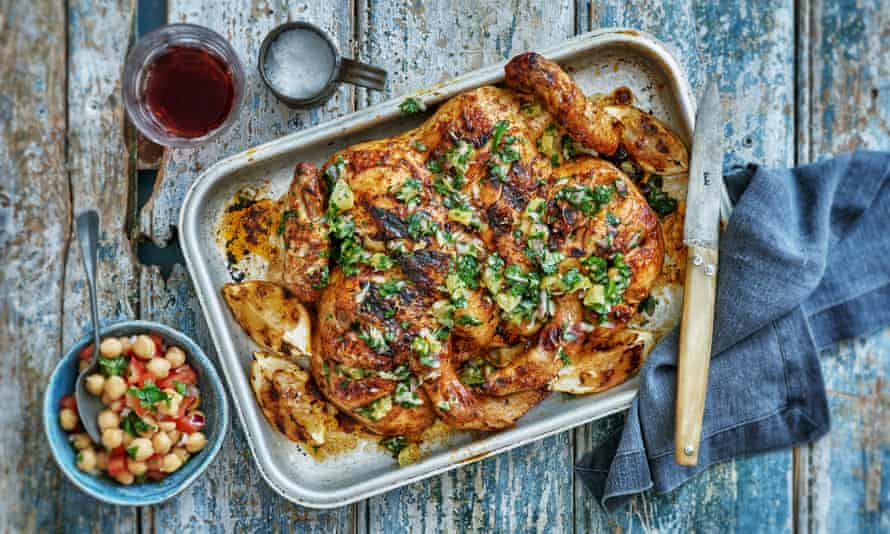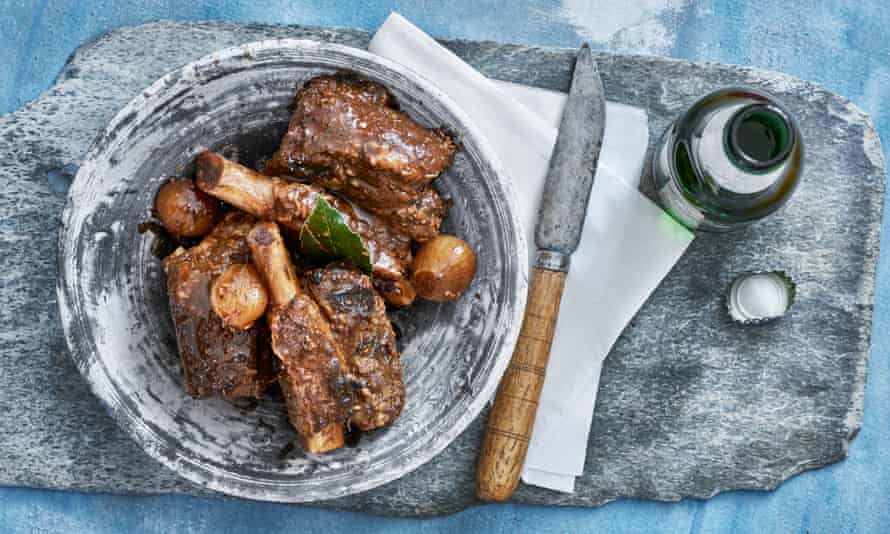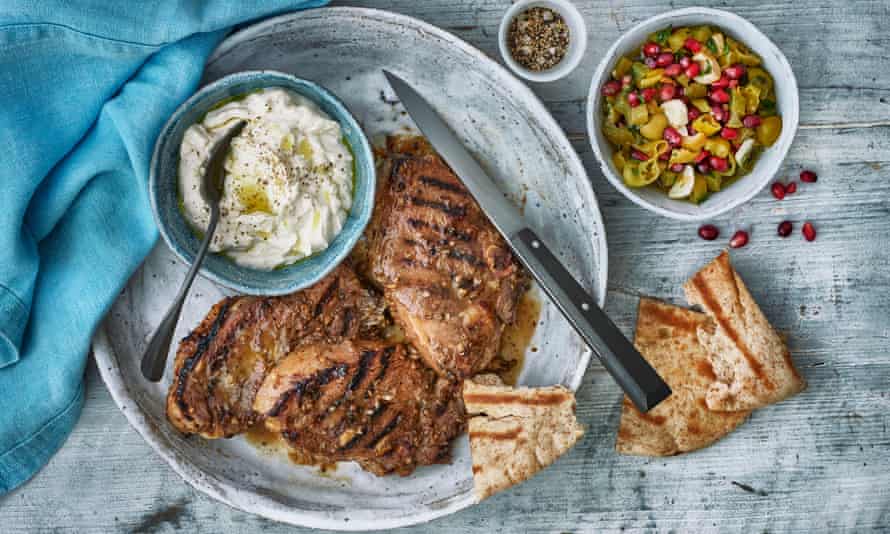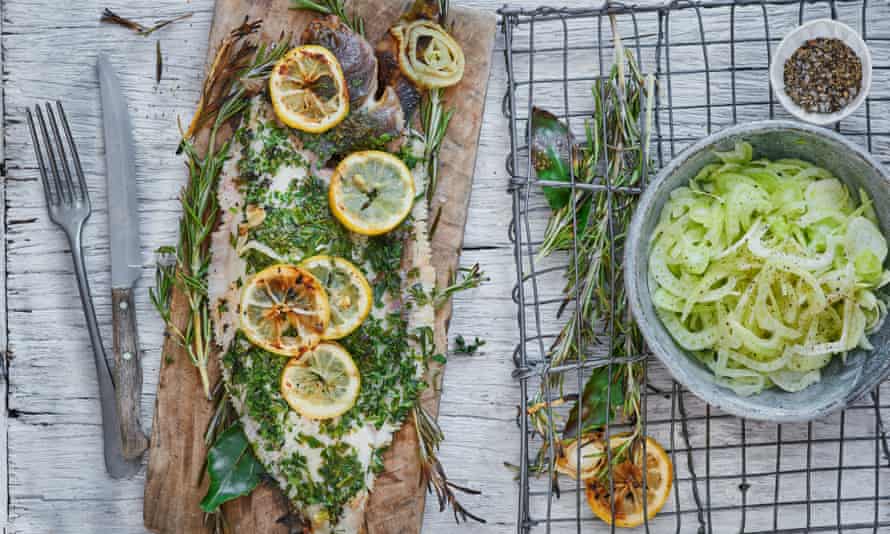Tom Kerridge Barbecue Rib of Beef
W hen he was 15, Tom Kerridge bunked off school to build a barbecue. A wall had fallen down behind his mum's house on the council estate in Gloucestershire where they lived, so Kerridge stacked the bricks and his mate Rob helped him mix the cement. "We stole sand from the sandpit at school, walking backwards and forwards," Kerridge recalls, evoking in reverse the subterfuge of the tunnellers in The Great Escape. It worked, and in fact the barbecue still stands on that spot.
So Kerridge loved barbecues even as a teenager? "I've always been a big fan of anything to do with food," he laughs. "But this was about just wanting to skive off school and have something fun to do."
Barbecue is fully established now as high food. Asador Etxebarri in the Basque country, number six in the World's 50 Best Restaurants list, infuses every course with smoke, even the ice cream. But it hasn't always been that way, especially not in Britain. One of Jamie Oliver's earliest food memories is of his dad swearing at the barbecue, terrible weather, charred sausages, but still "feeling brilliant".
Kerridge acknowledges you sacrifice some control when you cook on an outdoor grill, though that's part of the charm. Dinner parties are like going to opera, he reasons; barbecues are closer to stand-up comedy. When they're bad, they're excruciating, but when they're done right, they can be mind-blowing. "Barbecue is pretty unsubtle," says Kerridge. "And my style of cooking is never really about finesse; it's all about flavour. You can always tell when pork kebabs have been cooked on coals."
Thankfully, we have significantly upped our barbecuing skills, and carbonised sausages should, for most of us, be a distant memory. "If you're struggling to cook sausages on the barbecue, you should probably hand it over to your partner," he says. "Or your nine-year-old child. They'll probably do it better than you!"
Kerridge is onto something here. We might not have the culture of outdoor grilling that exists in places such as South Africa, Korea or the southern states of America, but ambitious home cooks in Britain are starting to adopt and adapt elements from all those cultures. "Because we haven't got an inherent style, we can pick and choose variants from all over the world," he says. "It's a bit like British cuisine: we choose the bits and bobs we want and make it our own.
"Cooking on coals and fire is more sensitive and intuitive than a lot of other cooking," Kerridge continues. "Rather than it being a recipe where you stick it on gas mark 4 for one and a half hours, take out, rest, you've got to cook it till it's done and you only know that through touch and feel. And that's why chefs enjoy it, because it's not necessarily systemised and there's risk there."
For OFM, Kerridge has selected recipes that nod to this global wanderlust. The spatchcocked chicken is given a Moroccan tang by a ras el hanout rub; the thick-cut Barnsley chops are marinated in Lebanese spices. The beef short rib is slathered in English mustard and cooked in stout, but borrows cooking techniques from the Deep South. Some dishes involve more planning and time than others, but Kerridge hopes the recipes will be accessible to all.
"If you want to do a proper American-style slow-cooking barbecue, then you'll probably want to start thinking about it on Thursday to cook it on Sunday," he says. "But there's nothing wrong with rushing out to Sainsbury's, getting a chicken, spatchcocking it and sticking it on the barbecue on the day.
"Summer's here, enjoy it and set fire to lots of stuff," he continues. "What's the worst that can happen?"
Kerridge, who once cooked exclusively on a barbecue for a month while his home was being renovated, has to work harder to find opportunities to grill at home these days. As well as the Hand and Flowers, the two-Michelin-starred pub he runs in Marlow, Buckinghamshire, and the Coach, down the road, this year he is set to come to London. The site is the old Rib Room at the Jumeirah Carlton Tower hotel in Knightsbridge.
"We're hoping for a 2017 opening, but we haven't got a firm date yet," he sighs. "If you can tell me a builder that comes in on time and under budget, that would be brilliant!"
Still, over the summer, Kerridge will be scanning the weather forecast for a hot Sunday to fire up the grill. On the menu? "Something like the short rib is always a big winner," he says. And to drink? "It's all about the ginger beer now. Cheers, chief!" Tim Lewis
Spatchcock chicken with ras el hanout and coriander dressing

A fantastic way of cooking chicken outdoors, allowing legs and breasts to cook evenly and prevent drying out. The marinade also works with lamb and fish on the bone.
Serves 4
free-range chicken 1 x 2kg
ras el hanout 4 tbsp
garlic 4 cloves, grated
olive oil 5 tbsp
salt 1 tsp
lemon 1, quartered
runny honey 3 tbsp
For the dressing
fresh coriander 1 large bunch, roughly chopped
garlic 2 cloves
salt ½ tsp
shallots 3, peeled and diced
preserved lemon 1, diced
green chilli 1, sliced
olive oil 3 tbsp
Lay the chicken onto a baking tray and score with a sharp knife. In a bowl, add the ras el hanout, garlic, olive oil and salt and give a good stir together. Next, rub the spice mix all over the chicken and pop in the fridge for an hour or so.
While the chicken is marinating, put the coriander, garlic and salt in a pestle and mortar, crushing the ingredients together until you have a fine paste. Stir in the shallot, lemon and chilli and oil, give a good stir and keep to one side.
Remove the chicken from the fridge, add the lemon quarters and lay the tray onto the barbecue, close the lid and cook for 30 minutes. After this time, remove the chicken from the tray, lay on the hot barbecue bars and cook for a further 8 minutes each side. Brush on the runny honey, remove from the heat, then leave to rest for 20 minutes.
Return the chicken to the roasting tin and coat in the spicy dressing, serve in the middle of the table, with some aromatic couscous or chickpeas.
Wine match
Marvelous Yellow, Western Cape, South Africa 2016 (£9.75, Oddbins)
A full-flavoured blend of five grape varieties led by chenin blanc, this supremely versatile modern Cape white has the power and fleshiness of tropical fruit to cope with the spicy-herby assault, and the floral fragrance and luminous acidity to wash away the spice and sweetness. David Williams
Salted cucumber with satay sauce

Cucumber and peanuts are such a great combination. The sweet nuttiness goes well with crisp, clean cucumber that comes with an extra hit of flavour from being toasted on the barbecue.
Serves 8
cucumbers 3, peeled
flaky salt 2 tsp
peanut oil 3 tbsp
lime juice of 1
chilli flakes 1 tsp
For the satay sauce
onion 1, peeled and blended
garlic 2 cloves
turmeric ½ tsp
coconut milk 1 tin
red chilli 1, sliced
lemongrass 1 stick, finely chopped
peanuts 250g, peeled and roasted
ketjap manis 50ml
limes juice of 2
To finish
spring onions 8, sliced thinly
fresh coriander 3 tbsp, chopped
green chilli 1, sliced
limes 2, cut into wedges
Split the cucumbers lengthways and lay on a tray, flat side up, then sprinkle over the flaky salt and leave for an hour or so. This does two things– it draws out the moisture and seasons the cucumber.
While the cucumber is salting, make the satay sauce. Put a splash of oil in a frying pan and fry the onion till it starts to colour, add the garlic and turmeric and cook out for a minute or so. Next add the coconut milk, chilli and lemongrass, bring to the boil, then remove from the heat and leave to cool.
Once cool, add to a food processor and blend to a coarse puree. Add the peanuts and pulse blitz. Season with the ketjap manis and lime juice and tip into a serving bowl.
To cook the cucumbers pat the flat side with a kitchen cloth and drizzle with a little peanut oil. Place them flat side down onto a hot barbecue griddle and cook for 3 to 4 minutes. Turn over, cook for 2 more minutes and remove from the heat. Place them on a tray, pour over the lime juice and chilli flakes, slice the cucumber into bite-sized dipping pieces and place on a salad plate. Warm the satay sauce and spoon over, top off with the spring onions, coriander, green chilli and serve with the lime wedges to squeeze over the top.
Wine match
Tapada de Villar Vinho Verde, Portugal 2016 (£9, Marks & Spencer)
The light, fresh, graceful tropical and stone-fruit salad flavours of this classy modern vinho verde would be good with any mildly spicy vegetable or seafood dish, and it works just brilliantly with the fresh but layered flavours here, the salty minerals doing a like-for-like thing with the cucumber. DW
Pork burgers with sauce gribiche and burnt onions

It's not a proper barbecue without a burger. This is my porky twist on a beef classic, inspired by great French cooking with a heavy garlic seasoning and finished with the most classic of dressings, a gribiche.
Serves 4
For the burger mix
minced pork belly 800g
garlic 3 cloves, grated
cracked black pepper ½ tsp
flat-leaf parsley 2 tbsp, chopped
sage 1 tsp, chopped
dry breadcrumbs 40g
English mustard 1 tbsp
shallots 3, finely diced
salt 1 tsp
For the sauce gribiche
hard-boiled eggs 2, coarsely grated
dijon mustard 2 tbsp
red wine vinegar 1 tbsp
cornichons 1 tbsp, roughly chopped
superfine capers 1 tbsp
parsley 1 tbsp, chopped
chervil 1tbsp, chopped
good extra virgin olive oil 150ml
For the burnt onions
vegetable oil 1 tbsp
butter 25g
onions 4, finely sliced
salt ½ tsp
To serve
sesame brioche buns 4, toasted
gem lettuce 1, broken down into leaves and washed
To make the pork burgers, combine the pork mince, garlic, cracked black pepper, both herbs, breadcrumbs, mustard, diced shallots and salt, then work the meat mix for a minute or so until it forms a large ball.
Divide into four, roll each into a burger shape and chill in the fridge for 2 hours or so, to firm up and let the flavour work into the meat.
For the gribiche dressing, place all the ingredients in a mixing bowl and give a good stir, then pop it in the fridge until needed.
For the burnt onions, warm the vegetable oil in a large shallow frying pan until hot, then add the butter and heat till foaming. Next, add the onions and salt, stirring from time to time until they start to colour. Fry the onions till they are dark and glossy, adding a little more butter if required. When the onions look like they are beginning to char remove them from the heat and leave to cool.
When your barbecue is ready, lay on the burgers and cook for 4 minutes each side. Remove from the heat and rest for 3 minutes.
Lay each burger on the bottom half of a bun and add a large spoonful of the burnt onions, then a generous spoonful of the dressing and the gem leaves. Top off with the bun top and serve.
Wine match
Arborescence Fronton, France 2016 (£5.99, Lidl)
The vivid, fresh reds made from the négrette variety in the Fronton appellation are popular in the bistros of nearby Toulouse for a reason: the peppery-spiced succulence of raspberry and blackberry fruit is brilliant with the local sausages or, in this case, pork burgers. DW
English mustard and black pepper crusted short rib

This can be cooked in the kitchen first and finished on the barbecue, or just cook it in the oven if the weather gets the better of you.
Serves 6-8
coarse ground pepper 6 tbsp
fennel seeds 4 tbsp
smoked paprika 3 tbsp
English mustard 8 tbsp
short rib 1 x 4kg piece
stout 1.15 litres
chicken stock 570ml
pickled onions 12
thyme 6 sprigs
Lay the pepper, fennel seeds and paprika in a heatproof dish and put into the oven at 160C/gas mark 2½ for 8 to 10 minutes or until toasted: you should have a wonderful aroma coming from the tray. Tip into a spice grinder and blitz to a coarse crumb. With a pastry brush, spread the mustard all over the short rib before packing on the spice mix. Make sure the rib is completely covered.
Place the short rib in a roasting tin along with the stout, stock, pickled onions and thyme. Cover the tray with a few layers of tin foil and put onto the barbecue – this should be cooked at a lower temperature. If you have gas, cook it at 100C. If you are using charcoal, the best time to cook this is after you have cooked your burgers and sausages, and you have loads of heat left but nothing else to cook except the rib. While the coals are white add the dish to the barbecue: if it still feels hot don't worry the stock will steam the rib. Place the lid on the barbecue and cook for 4 to 5 hours or until tender.
Once cooked, remove from the heat and reduce the liquid to a glaze, spoon over the top of the rib and serve in the middle of the table (if you like, flake the meat and bind it with the stock).
Wine match
Definition Shiraz, Barossa Valley, Australia 2016 (£12.99, Majestic)
A rich, intensely flavoured wine for a rich, intensely flavoured dish, this dense, hearty but beautifully polished and poised red is a classic Barossa shiraz, the slight sweetness of the plump dark fruit given extra depth with a lick of salted liquorice. DW
Lebanese-spiced Barnsley chops with tahini dressing and pickled chilli salsa

One of the most underused but delicious cuts of lamb. This Middle Eastern twist is great for the outdoors and has such a warming holiday feel to it, brought together by the flavour of sesame.
Serves 4
olive oil 6 tbsp
garlic 5 cloves, grated
cumin seeds 2 tsp, toasted and crushed
coriander seeds 2 tsp, toasted and crushed
sumac 1 tsp
salt 1 tsp
honey 1 tbsp
Barnsley chops 4, thick cut
For the tahini dressing
Greek yogurt 200g
tahini 70ml
garlic 2 cloves, grated
lemon juice of 1
For the pickled chilli salsa
green pepper 1, finely diced
pickled green chillies 8, sliced
garlic 1 clove, sliced thickly
olive oil 50ml
spring onions 8, sliced
pomegranate seeds 3 tbsp
green olives 10, roughly chopped
mint 10 leaves, chopped
lemon juice of 1
Put the oil, garlic, cumin, coriander, sumac, salt and honey in a large bowl. Mix well and rub all over the Barnsley chops, making sure they are fully covered in the spice. Lay the lamb on a tray and put into the fridge for 2 hours.
For the dressing, place the yogurt, tahini, garlic and lemon juice in a mixing bowl, give them a little whisk and store in the fridge until needed.
To make the pickled chilli salsa, saute the green pepper in a little oil, add the pickled chilli, garlic and olive oil, warm for a minute or so, then remove from the heat and leave to cool.
Next, stir in the spring onions, pomegranate seeds, olives, mint and lemon juice, adding a little seasoning if necessary.
To cook the lamb, season with a little salt and lay directly onto the barbecue, leave for 5 minutes or so, then flip over and cook for a further 3 to 4 minutes. If you like your lamb well done, leave for another 3 minutes. Remove the chops from the barbecue and rest on a warm plate. When ready to serve, drizzle with the tahini dressing and a large spoonful of the salsa.
Wine match
Les Hauts de Saint Martin Saint-Chinian, France 2014 (£6.99, The Co-op)
The spicing may be inspired by another part of the Med, but this supple blend of syrah and grenache from the Languedoc is perfectly pitched for chops and sauce. Juicy freshness cuts through the fat. DW
Aromatic lemon sole with bay and fennel tops

This recipe is a simple as they come but packed with flavour. I love cooking fish this way – start with lemon sole and work up to cooking a bigger fish, such as bass, turbot or brill. Cooking the fish in a clamp keeps it held together and allows "garden" flavours of bay and fennel to work their magic.
Serves 2
lemon sole 2, dark skin removed
soft butter 200g
tarragon 1 tbsp, chopped
chervil 1 small bunch, chopped
dill 1 bunch, chopped
lemon 1, sliced
bay leaves 8 large sprigs
fennel tops 4
rosemary ½ bunch
fish clamp 1 big enough for 2 fish
To prepare the lemon sole, lightly season with a little salt and spread the butter evenly over both sides, then sprinkle with the chopped herbs. Next, cover the fish with the lemon slices. Pop the fish in the fridge for a few minutes.
Lay the fish clamp on a chopping board and open it up, lay the bay and fennel tops onto the clamp and then the rosemary – there should be no gaps showing through. Lay the buttered soles on top and close the fish clamp. The fish should be surrounded by herbs.
Lay the herb and fish parcel onto the barbecue. The herbs will cook and steam and transfer their flavour into the fish. Cook the fish over the coals for 8 to 10 minutes. This seems a long time but it takes a while for the heat to get through the herbs. When the fish is cooked remove from the barbecue and rest on a plate. Open the fish clamp carefully and remove the herbs from the fish, then remove the fish from the remaining herbs, spoon over some of the resting juices and barbecued lemon slices. Serve with some shaved fennel.
Wine match
Morrisons The Best Gavi, Italy 2016 (£7, Morrisons)
Bright dry whites made from cortese in the Gavi zone of Piedmont are made with grilled fish in mind, and, with its tang of preserved lemon, crisp pear and apple, light floral tones and Alpine-fresh acidity, this is one of the best from the supermarkets. DW
How smoke works
One of the reasons why people love barbecuing over wood or charcoal is that it gives rise to flavours you simply don't get when cooking with gas or electricity. This is all down to smoke – the complex mix of particles, gases and water vapour released from the burning fuel.
Not all smoke is created equal. Charcoal, according to Richard Turner of Hawksmoor, is "the most convenient fuel source there is". It burns hotter and longer than wood, emitting a steady, even heat, but it doesn't produce much smoke or any real flavour of its own. What smoke does issue from charcoal is caused by drippings from the food, rich with sugars, proteins and oils, being vaporised by the hot coals and forging new aromas that travel back up to infuse the food on the grill.
"If you want to up your barbecuing game," says Turner, "use wood." Wood can give rise to a wider variety of flavours, depending on the type you use and how you use it.
With wood, the smoke comes from volatile compounds which when burned, produce aromatic compounds such as syringol and guaiacol. Particles and gases in the smoke stick to the surface of foods, particularly when moist, and build up flavour over time (there's not much point in sourcing aromatic wood if you're only cooking a few sausages).
In general, barbecue masters tend to avoid softwoods, which burn faster and can give off noxious gases; also, wood needs to be properly dried. Your choice of wood largely depends on what you're cooking. "Most steak chefs will cook over oak," says Turner, "but I'm a big fan of cherry wood and will use it for all kinds of meat. It gives a sweetness that works really well with pork." He goes on: "Pine to me is like Voldemort. It's totally wrong for meat, but I know fish chefs cook over pine, because the flavour works."
Where you are in the world is another factor. For his restaurant Ekstedt in Stockholm, which specialises in food cooked over wood fires, Niklas Ekstedt mostly buys birch because it's abundant in Sweden and therefore economical. "We go through a cubic metre a day," he tells me. Ekstedt also likes to mix his sources of heat and smoke. "You can play around with burning wood and charcoal together. You get a longer and more stable heat from the charcoal, but more smoke and flavour from the wood." Killian Fox
Source: https://www.theguardian.com/lifeandstyle/2017/jul/16/tom-kerridge-barbecue-recipes-lamb-chops-lemon-sole-pork-burgers
Belum ada Komentar untuk "Tom Kerridge Barbecue Rib of Beef"
Posting Komentar